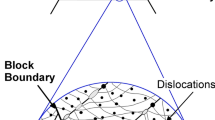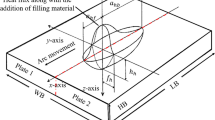Abstract
The flame straightening of steel components is based on heating a local region of the part by means of a torch in order to induce a permanent deformation through a field of residual stresses. Although this is a very common practice, it is not devoid of serious drawbacks. In this paper, the influence of the flame bending procedure on the microstructure of three very different structural steels (S235 JR, S460 ML and S690 QL, respectively), widely used for the construction of metallic structures, is analysed. The consequences of the heat treatment on the mechanical and fracture properties were characterised through micro-hardness Vickers and Charpy impact tests; in addition, some elastic-plastic fracture tests were performed on precracked Charpy specimens manufactured with the S235 JR steel. The relationship between the microstructural features and the material mechanical and fracture behaviour was studied in depth in all cases, correlating the changes induced by the flame heat treatment on the microstructure with the macroscopic mechanical and fracture response. For a proper understanding of the microstructural consequences of this straightening heat treatment, it was necessary to develop a Finite Element numerical model. Based on the experimental results, this study has revealed that the consequences of the flame straightening on the microstructure, mechanical or fracture behaviour strongly depend on the nature of the material; for this reason, it is not possible to establish general recommendations. Nevertheless, the paper proposes a series of guidelines for good practice for steels similar to those characterised here.






















Similar content being viewed by others
References
Avent RR (1989) Heat-straightening of steel: fact and fable. J Structural Eng 115(11):2773–2793
Avent RR, Mukai DJ, Robinson PF (1998) Heat-straightening repairs of damaged steel bridges, a technical guide and manual of practice. Report No FHWA-IF-99-004, Federal Highway Administration, USA
Avent RR, Mukai DJ (2000) Heat-straightening rolled shapes, a technical guide and manual of practice. J Structural Eng 126(7):755–763
Avent RR (1995) Engineered heat straightening comes of age. Mod Steel Constr 35(2):32–39
Avent RR (1992) Designing heat straightening repairs, Proc. Nat. Steel Constr Conf, American Institute for Steel Construction (AISC)
Kumar AS, Kumar BR, Datta GL, Ranganath VR (2010) Effect of microstructure and grain size on the fracture toughness of a micro-allowed steel. Mater Sci Eng, A 527(4–5):954–960
Ray PK, Ganguly RI, Panda AK (2003) Optimization of mechanical properties of an HSLA-100 steel through control of heat treatment variables. Mater Sci Eng, A 346(1–2):122–131
Yaowu S, Zhunxiang H (2008) Effect of weld thermal cycle on microstructure and fracture toughness of simulated heat-affected zone for a 800 MPa grade high strengh low alloy steel. Mater Sci Eng, A 207(1–3):30–39
Machado IF (2006) Technological advances in steels heat treatments. Mater Sci Eng, A 172(2):169–173
European structural steel standard EN 10025: 2004 Part 2—Technical delivery conditions for non-alloy structural steels
European structural steel EN 10025: 2004 Part 4—Technical delivery conditions for thermomechanically rolled weldable fine grain structural steels
European structural steel EN 10025: 2004 Part 6—Technical delivery conditions for flat products of high yield strength structural steels in the quenched and tempered condition
Bain EC, Paxton HW (1961) Alloying elements in steel, American society for metals
Heat treating (2004) 10th ed. In: ASM Handbook Vol. 4. ASM international, Ohio
ANSYS user’s manual. Release 14; 2011
Moshiov A, Lattore R (1985) Temperature distribution during plate bending by torch flame heating. J Ship Res 29(1):1–11
Lee JH (1995) Relations between input parameters and residual deformations in line heating process, Ph.D. Thesis, Department of Naval Architecture and Ocean Engineering, Seoul National University, Seoul, Korea
Rykalin NN (1960) Calculation of Heat Process in Welding, Mashinostroenije Moscow
Manca O (1995) Quasi-steady-state three-dimensional temperature distribution induced by a moving circular Gaussian heat source in a finite depth solid. J Heat Mass Trans 38(7):1305–1315
Metallography and Microstructures (2004) tenth ed. In: ASM Handbook Vol. 9. ASM international Ohio, pp 598
Degarmo EP, Black JT, Kohser RA (2003) Materials and Processes in Manufacturing, 9th edn. Wiley
Pero-Sanz JA (2004) Aceros: metalurgia física, selección y diseño, Dossat 2000. Cie, S.L
ASTM E8-04 (2005) Standard Test Methods for Tension Testing of Metallic Materials. In: Annual Book of ASTM Standards, vol 03.01. ASTM, Philadelphia
ASTM E23-01 (2005) Standard test methods for notched bar impact testing of metallic materials. In: Annual Book of ASTM Standards, vol. 03.02 [section 3]. ASTM, Philadelphia
Anderson TL (1995) Fracture Mechanics, Fundamentals and Applications, second ed., CRC Press
Kanninen MF, Popelar CH (1985) Advanced Fracture Mechanics, Oxford University Press
Rice JR (1968) A path independent integral and the approximate analysis of strain concentration by notches and cracks. J Appl Mec 35:379
ASTM E1820-01 (2005) Standard Test Method for Measurement of Fracture Toughness. In: Annual Book of ASTM Standards, vol. 03.02 [section 3]. ASTM, Philadelphia
G. Krauss (1997), STEELS: Heat treatment and processing principles. ASM international
Acknowledgments
This paper describes the work performed by the Laboratory of the Division of Science and Engineering of Materials (LADICIM) of the University of Cantabria within the project OPTISTRAIGHT (Optimization and improvement of the flame straightening process, Contract N°: RFSR-CT-2007-00040). This Project was carried out with the financial grant of the Research Programme of the Research Fund for Coal and Steel; technical contributions from the members of the OPTISTRAIGHT members and the financial contribution from the Research Fund for Coal and Steel are gratefully acknowledged. The authors would also like to express their particular gratitude to the technical staff of DEGIMA S.A. and, specially, to Mr. Luis San Segundo, without whom it would have not been possible to conduct the experimental part of the present research.
Author information
Authors and Affiliations
Corresponding author
Rights and permissions
About this article
Cite this article
Lacalle, R., Álvarez, J.A., Ferreño, D. et al. Influence of the Flame Straightening Process on Microstructural, Mechanical and Fracture Properties of S235 JR, S460 ML and S690 QL Structural Steels. Exp Mech 53, 893–909 (2013). https://doi.org/10.1007/s11340-013-9723-8
Received:
Accepted:
Published:
Issue Date:
DOI: https://doi.org/10.1007/s11340-013-9723-8




